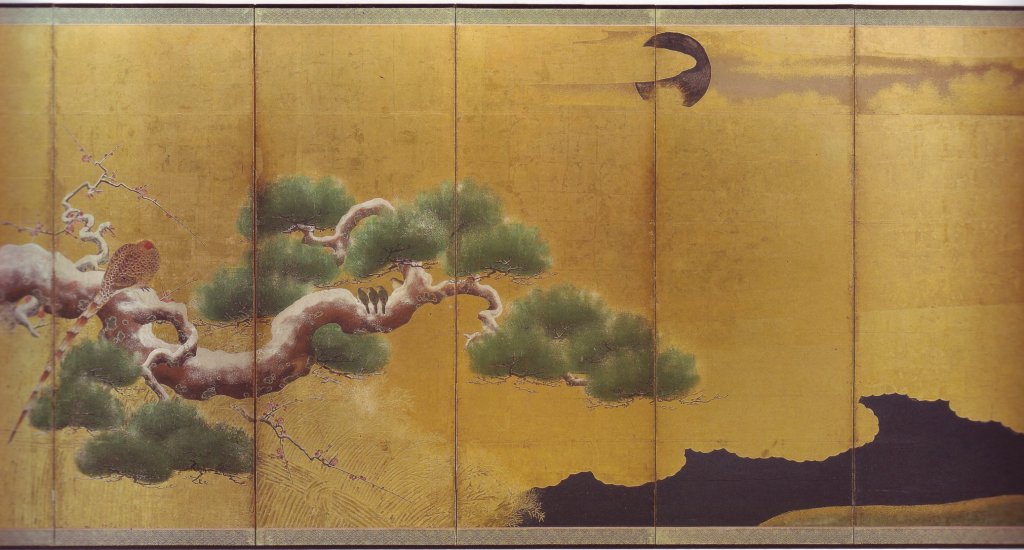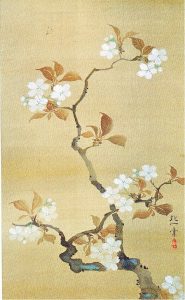Buddhism, introduced to the Japanese imperial court around 552 A.D. as the salvific religion of the state, greatly influenced the compositional rules of ikebana also because these were created by Buddhist monks and moreover, in ancient Japan, every human manifestation had to be in accordance with the religions.
The first monks who created the first rules of ikebana were the dōbōshῡ (attendants) employed by the Ashikaga shoguns (most of them, at the beginning of the Ashikaga dominance, belonged to the Ji-shū Buddhist branch – founded in the 13th century by Ippen, a monk formed in the Tendai sect – who were later replaced at the fall of the Ashikaga shogunate by the Ikenobo, also belonging to the Tendai sect).
The compositional rules of ikebana reflect the Buddhist theory of interdependence (anatta), for which reality exists as a network of relations; these relations are manifest in ikebana both as in the relationship between the measure of the vase and that of the plants, both as a relationship of “forces” between plants and also in the relationship between the composition and the environment that surrounds it.
Let’s analyze the relationship between plants.
By “optical weight” we mean the visual sensation of strength that a vegetable gives us and it is based on multiple factors such as colour, shape and volume.
The ikebanist, while constructing his composition, must refer to this concept so that the “optical force” (optical weight) of the three main elements ( that in the Ohara School are called shu, fuku and kyaku) must be well diversified and unmistakable: shu-shi must be rendered with an “optical force” greater than that of fuku-shi and in turn fuku-shi must be rendered with an “optical force” greater than that of kyaku-shi.
Even the chukan-shi (Fillers) in the composition must have a lower optical weight than the vegetable of which they are auxiliaries: “the chukan-shi are subordinate to the vegetable of which they are auxiliaries”.
 |
Another example to understand this concept is to see the first three awarded athletes on a podium: – the 1st (in the middle on the highest step) won because his “muscle strength” is greater than that of the 2nd (to the right of the first and on a lower step) which, in turn, has a “muscle strength” greater than the “muscle strength” of the 3rd (on the lowest step of the three).
|
| In an ikebana arrangement the concept is similar: in the Chokuritsu-kei, hongatte composition, from which all the other styles originated, the three main elements are comparable, both in their position and in their “strength” to the three athletes on the winners’ podium. Using Ohara school terminology, shu-shi is in the middle and is comparable to the 1st athlete, fuku-shi, the 2nd athlete, is on his right while kyaku-shi, the 3rd athlete, is on his left; like the three athletes who have decreasing “muscle strength”, shu-shi, fuku-shi and kyaku-shi have decreasing “optical weight”.
Since all the other styles in Shikisai Moribana and Heika all derive from the Chokuritsu-kei, even though the shu-shi position changes from the original Chokuritsu-kei, the difference of the “optical weight” of the elements used has not changed. |
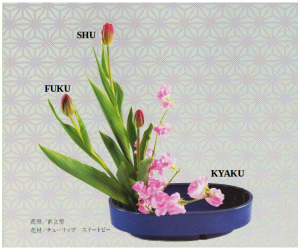 |
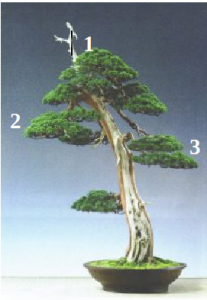 |
Also in bonsai the same concept is applied as in the design of the screen – pheasant and pine-. The construction and the optical weight of the three main canopies are based on the same concept of shu-shi, fuku-shi and kyaku-shi, both in terms of placement and optical weight.
The bigger canopy in the centre, corresponds to the shu-shi in the Ohara School, the middle one on the right, corresponds to fuku-shi and the smaller one on the left, corresponds to kyaku-shi.
|
The ikebanist pupil is taught to measure branches and flowers according to the mass or shape of their corolla: the diagram below shows how plants, in order to maintain the same optical weight, are lengthened or shortened according to the shape of their corolla or inflorescence.
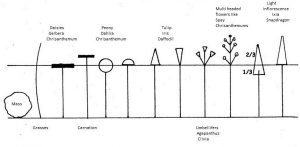
In the concept of “optical weight”, measurements are only one of the components that determine it because many other factors such as colour, ” age” of the branches, ” youth” of the leaves, leaf/wood or leaf/stem ratio, the stage of development of the plants, and many others are taken into account.
Examples in which, despite being of equal size, element A is “optically heavier” than element B
 |
To make B of “equal optical weight” with respect to A, this must be lengthened as in C
 |
A and C now have equal “optical weight”.
– using scissors, but once cut or thinned it can no longer be reinforced; the only way to reinforce it is to add an auxiliary; therefore, before using the scissors, you need to think twice! If vegetable B has been cut, the only way to reinforce it and make it the same weight as A is to add one of its auxiliaries
 |
now A and B have the same “optical weight”
what is “heavy” goes to the center of the composition, what is “light” to the periphery “.
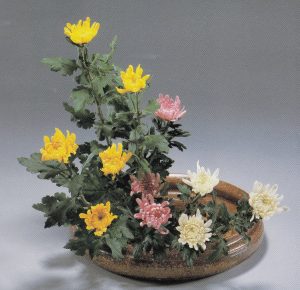 |
The dark colors go to the center of the composition, the light ones to the periphery as, for example, in the traditional Moribana of Color with chrysanthemums in which the Color Band is composed of darker colors than the colors of the shu-fuku and kyaku group. |
|
|
|
|
This concept is clearly visible in the famous drawing entitled -sei kaki-, attributed to the Chinese monk Mu Qi, late 13th century. in which the darker shades are in the center and the lighter ones in the periphery (see article 56 °: the six khaki of Mu Qi) |
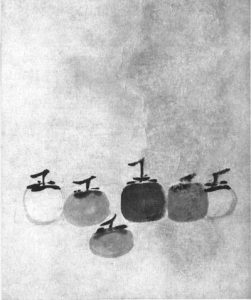 |



